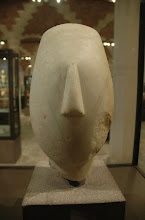 March 10, 2008, 3:01 pm
March 10, 2008, 3:01 pmSeven More Sins, Thanks to Vatican
By Mike Nizza
(painting: "The Papacy Crowning themselves Kings")
Lust, gluttony, greed and the rest of the seven deadly sins gathered in the 6th century will have
to get used to a modern companion. A Vatican official has articulated seven new categories of sin “due to the phenomenon of globalization.”
“While sin used to concern mostly the individual, today it has mainly a social resonance,” Monsignor Gianfranco Girotti told L’Osservatore Romano, Vatican City’s local paper. Bloomberg News parsed his remarks into a clip-n-savable list:
1. “Bioethical” violations such as birth control
2. “Morally dubious” experiments such as stem  cell research
cell research
 cell research
cell research 3. Drug abuse
4. Polluting the environment
5. Contributing to widening divide between rich and poor
6. Excessive wealth
7. Creating poverty
4. Polluting the environment
5. Contributing to widening divide between rich and poor
6. Excessive wealth
7. Creating poverty
Is it just me or is this a joke? Being that historically, the Catholic church not only actively directly and indirectly participated in #1, #3, #5, #6 and #7 (and probably #4 as well...) on their new list of sins, but often boasted, reveled and proudly exhibited most of these characteristics.
#1: It is known that the bearing of countless bastard children, and encouraging their mistresses to end their unwanted pregnancies often resulting in the "silencing" of certain mistresses that refused to do so, was commonplace . ("How many papal mistresses have been known in history? How many literary works -- Umberto Eco's The Name of The Rose comes to mind -- and scholarly histories through the centuries have described priestly sexual liaisons and priest-produced pregnancies? "http://www.commondreams.org/views02/0426-06.htm)
And having a history as being the single most wealthy country and government in the world with the largest physical monetary holding makes #6 and certainly #5 ludicrous. ("Bankers' best guesses about the Vatican's wealth put it at $10 billion to $15 billion. Of this wealth, Italian stockholdings alone run to $1.6 billion, 15% of the value of listed shares on the Italian market. The Vatican has big investments in banking, insurance, chemicals, steel, construction, real estate." http://www.time.com/time/magazine/article/0,9171,833509,00.html)
There is a somewhat endless well of evidentiary support in the art world; mostly pictorially immortalized in paintings and frescos, in addition to other written evidence that has been found, and no doubt destroyed or safely guarded deep within the Vatican archives.
"The Roman Catholic Church tried to kill off all remnants of this dynasty and their guardians, the Cathars and the Templars, in order to maintain power through the apostolic succession of Peter, instead of the hereditary succession of Mary Magdalene."
Resources:
Pierre Plantard de Saint-Clair, L’Or de Rennes, mise au point (La Garenne-Colombes, 35 bis, Bd de la République, 92250; Bibliotheque Nationale, Depot Legal 02-03-1979, 4° Z Piece 1182).
Jean-Luc Chaumeil, Rennes-le-Château – Gisors – Le Testament du Prieuré de Sion (Le Crépuscule d’une Ténébreuse Affaire) Editions Pégase, 2006
The Times, 18 January 1982.
The Real Da Vinci Code, Channel Four Television, presented by Tony Robinson, transmitted on 3 February 2005.
Bill Putnam, John Edwin Wood, The Treasure of Rennes-le-Château, A Mystery Solved (Sutton Publishers, 2003).
Pierre Jarnac, Les Archives de Rennes-le-Château, Tome I, p.197-198 (Editions Bélisane, 1987)
Jean-Luc Chaumeil, La Table d'Isis ou Le Secret de la Lumière, p. 121-124. (Editions Guy Trédaniel, 1994, ISBN 2-85-707-622-3)
Massimo Introvigne, Gli Illuminati e il Priorato di Sion (Piemme, Milano 2005).
Bernardo Sanchez Da Motta, Do Enigma de Rennes-le-Château ao Priorado de Siao - Historia de um Mito Moderno(Esquilo, 2005).
Jean-Jacques Bedu, Les sources secrètes du Da Vinci Code (Éditions du Rocher, 2005).
Franck Marie, Rennes-le-Château, Etude Critique (SRES, 1978)
Jean-Luc Chaumeil, Rennes-le-Château – Gisors – Le Testament du Prieuré de Sion (Le Crépuscule d’une Ténébreuse Affaire) Editions Pégase, 2006
The Times, 18 January 1982.
The Real Da Vinci Code, Channel Four Television, presented by Tony Robinson, transmitted on 3 February 2005.
Bill Putnam, John Edwin Wood, The Treasure of Rennes-le-Château, A Mystery Solved (Sutton Publishers, 2003).
Pierre Jarnac, Les Archives de Rennes-le-Château, Tome I, p.197-198 (Editions Bélisane, 1987)
Jean-Luc Chaumeil, La Table d'Isis ou Le Secret de la Lumière, p. 121-124. (Editions Guy Trédaniel, 1994, ISBN 2-85-707-622-3)
Massimo Introvigne, Gli Illuminati e il Priorato di Sion (Piemme, Milano 2005).
Bernardo Sanchez Da Motta, Do Enigma de Rennes-le-Château ao Priorado de Siao - Historia de um Mito Moderno(Esquilo, 2005).
Jean-Jacques Bedu, Les sources secrètes du Da Vinci Code (Éditions du Rocher, 2005).
Franck Marie, Rennes-le-Château, Etude Critique (SRES, 1978)
Pierre Jarnac, Histoire du Trésor de Rennes-le-Château (Editions Belisane, 1985).





No comments:
Post a Comment